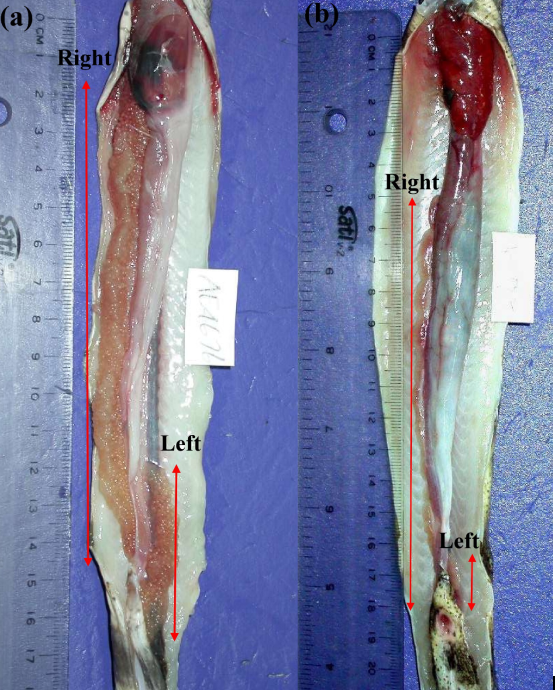右邊生殖腺較長是鯙科的「常規」?
右邊生殖腺較長是鯙科的「常規」?
生物特徵的研究,是生物學中基本的題目。生物外部特徵的不對稱由於很容易觀察,因此有較多研究。相反探討體腔內內臟器官不對稱的研究,卻是少之又少。為了解鯙科在生殖腺上左右不對稱的情況,此次研究調查了棲息在台灣海域中的20個鯙科及2種不同的鰻科物種,共2959尾個體。調查發現,所有鯙科物種的右邊生殖腺均比左邊的生殖腺明顯地長(如下圖),但2種非鯙科物種(合腮鰻科及蛇鰻科)的生殖腺皆沒有發現統計上顯著的左右不對稱。由此可見,生殖腺左右不對稱是鯙科物種獨有的。這現象被推測為鯙科在歷史演化中衍生出來的副產物。
研究團隊從2003年開始至2008年,從台灣北部及東部海岸,以不同方法收集樣本,其中大部分透過向漁民收集。研究團隊使用了2個指標去表明生殖腺長度的不同。分別是生殖腺左右長度比值跟生殖腺左右長度差值。透過數量龐大的樣本,及台灣多年來對鯙科的研究所累積下來的數據,最終使團隊能同時對多個物種進行調查及比較。
研究團隊指出,棲地類型、深度、物種的最終大小,以至分類學上的相似度均沒有發現重要的關聯性。生殖腺左右不對稱一直被認為是異常的現象,但對於鯙科卻有可能是一種常規。既然這個「常規」沒有對牠們的生存造成明顯的劣勢,影響牠們的族群數量,那為什麼會出現這個情況?性選擇及歷史演化副產物被認為是最有可能解釋的原因。但詳細因素,還需團隊往後進一步的研究。
Lin, Y.J. and Chen, H.M., 2023. Directional asymmetry in gonad length indicates moray eels (Teleostei, Anguilliformes, Muraenidae) are “right-gonadal”. Scientific Reports, 13(1), p.2963
Is a longer 'right-gonadal' the norm in moray eel species?
Studies about the external morphological traits form the very basis of biology. The studies of external traits of teleost are rich over the world due to its easy observation. However, the inner organs of teleost are rarely examined. To understand the directional asymmetry in the gonad length of Muraenidae and outgroups, Yu-Jia Lin, an assistant professor of the institute of Marine Ecology and Conservation at National Sun Yat-sen University and Hong Ming Chen, a professor of Department of Aquaculture, National Taiwan Ocean University investigated 20 species of moray eels (Muraenidae) and two outgroup species with 2959 individuals. They found out that moray eel species were generally having a significant longer right gonad length (Figure) but not occurred in the outgroups species. Indicating the directional asymmetry is unique in the moray eels species and is likely considered as a by-product in the evolutionary history without significant disadvantage in survival.
All the specimens were collected from eastern and northern Taiwan between 2003 to 2008 with various method, in particular collected from collaborating fishmen. The teams used two indicators to represent the directional asymmetry, the gonad length ratio(right divided by left) and the gonad length difference(right minus left).To remove the variation in sampling months, they used gonad length instead gonad weight to conduct the experiment. With large sample sizes and a considerable amount of accumulated valuable data, the teams successfully discovered that the directional asymmetry in gonad length is the unique norm in the moray eels.
The team observed that no correlation to major habitat types, depth and size classes, and taxonomic closeness of the species. The asymmetry in the gonad morphology was considered as an abnormal phenomenon . Nevertheless , the directional asymmetry in the gonad length appears to be a norm in the examined moray eel species and the possibility of natural variation can be ruled out. Although this norm doesn't negatively impact population dynamics, the question of why it occurs remains. Both the sex selection or a by-product in the evolutionary history are considered possible explanations for observed asymmetry in the moray eels. These possibilities can be explored and tested in future studies.
Lin, Y.J. and Chen, H.M., 2023. Directional asymmetry in gonad length indicates moray eels (Teleostei, Anguilliformes, Muraenidae) are “right-gonadal”. Scientific Reports, 13(1), p.2963

圖(a)雌性(b)雄性疏條紋裸胸鯙(Gymnothorax minor, ID: TOU-AE-4676 and TOU-AE-4592)的生殖腺圖。左右為當魚類頭朝上、腹部朝下時之左右側。拍攝者:黃麗雅。
Figure. (a) A female Gymnothorax minor, collection ID: TOU-AE-4676 and (b) a male collection ID: TOU-AE-4592, showing the measurement of gonad length at both sides. The ovary is enclosed in orange and testis in blue. The left side (L) and right side (R) are defined when the fish is head up and belly down, and therefore, left–right direction appears opposite when the belly is up as shown this figure. Scale bar = 1 mm. (Photo credit: Huang, L.Y.)

